Controversies of 1200 MW Teesta III HEP in Sikkim
Jiten Yumnam *
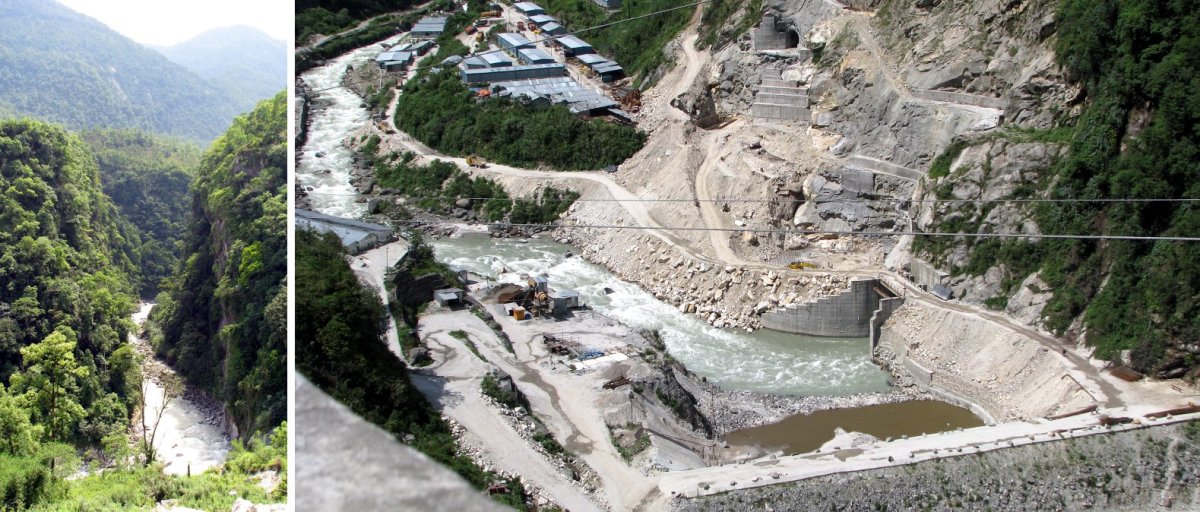
destruction in dzongu
India's power scenario of late, has been marked by renewed thrust of mega hydroelectric projects across India's North East, including classifying large hydros as renewable source of energy, to mobilize resources for large hydropower projects from international financial institutions, like International Financial Corporation of World Bank, to tackle high cost of power from hydros, to ease environment, forest and wildlife clearance procedures, to address issues of states refusing to sign Power Purchasing Agreements etc.
The 2880 MW Dibang Hydroelectric Project, the 1500 Tipaimukh dam etc are key mega projects pursued in India's North East while resumption of work for the stalled 2000 MW Lower Subansiri HEP over the Subansiri River has been announced. At least Thirty-Two (32) Dams are envisaged to be built over the Rivers of Manipur. It will be crucial to assess the issues associated with dams built across India's North East. Assessing the 1200 MW Teesta III Hydroelectric Project (Teesta III) in Sikkim, commissioned in February 2017 would be a crucial endeavour.
Teesta III & Indigenous Rights Violations: The Teesta Stage III consists of a 60-meter-high concrete-faced rockfill dam with two tunnel spillways, a reservoir flushing tunnel. The underground powerhouse contains six 200-MW turbine-generator units. Filling of the reservoir was completed on Sept. 15, 2016. The initial project cost of the Teesta III 1200-MW project was fixed at INR 5705 crores as per the Techno Economic Clearance (TEC) at 2005 prices.
By 2017, the project cost crossed INR 14000 Crores, also attributed to the earthquake in 2011, that destroyed major infrastructures of Teesta III. Andritz VA Tech Hydro supplied developer Teesta Urja Ltd. (TUL) the complete electro-mechanical package for six vertical Pelton units at Teesta-III.
The Teesta III project is one of the most controversial project requiring a deeper introspection not only on the nature of impacts, but also the nature of cooperation and collaboration among the Government, local authorities with the dam building corporations and the financiers transcending international boundaries. The project is built is one of the most fragile geology, biodiversity and cultures of indigenous peoples. The Teesta III was commissioned in February 2017, five years delayed from original plan .
For long, the Teesta III project features as one of the most destructive and unsustainable projects in Sikkim. The non-recognition of Lepcha peoples' rights over their land and their exclusion in decision making processes for dams on their sacred Teesta River remain key issues. The Lepcha peoples' relationship with their sacred Teesta River and their last reserve, the Dzongu have been completely dishonoured.
The blasting for construction of the project and boring of tunnels led to massive landslides in hills and destruction of houses near the dam site. A holistic impact assessment on ecology, seismic impacts, transmissions lines, impact of reduced flow and other impacts on Lepcha People such as blasting, is absent from its Environmental Impact Assessment (EIA). The environmental clearance granted to the project in August 2006 violates MoEF's own stipulation while clearing the Teesta Stage V hydroelectric project in May 1999, which stated that: "No other project in Sikkim will be considered for environmental clearance till the carrying capacity study is completed.".
However, the MoEF went against its own decision and granted Environmental Clearance to the project. The Teesta River basin holds 313 glacial lakes and any glacial lake outburst Floods can be expected to overflow the reservoir in Chungthang, causing massive damage in downstream areas of the Dam . Indeed, an enormous cloudburst in June 2019 caused heavy rain in the upper reaches of Teesta river in North Sikkim forcing the Teesta-III project management to release 600 Cumecs of water from the dam. The NHPC Guest House near Dickchu bridge has been washed away and a stretch of Road along the Teesta River slides away to the overflowing water. The Mantam foot suspension bridge collapsed in Upper Dzongu, cutting off Sakyong-Pentong, Bay and other villages .
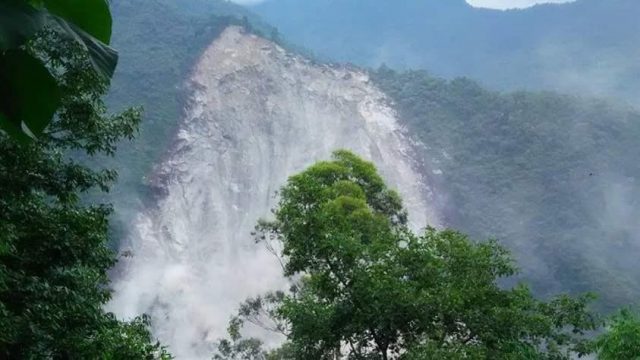
Land slides and tunnelling works
Teesta III as CDM project: The 1200 MW Teesta III project, one of India's largest hydropower projects has been classified as clean project at CDM to receive carbon credits by TUL. Presenting false information to UNFCCC to receive CDM benefits, the Teesta III project is not additional. The project developers failed to reveal that these projects are planning to seek CDM credits during stakeholder consultations and at public hearings, making the obligatory stakeholder consultation process under the CDM faulty. The dams in Sikkim are not green and clean and will only worsen global warming.
Teesta III financing & controversies: The Teesta Urja Limited (TUL) was formed to develop the project and has a build-own-operate-transfer contract for 35 years, after which the project will be returned to the government of Sikkim. TUL has been awarded the 1200 MW Teesta Stage III hydro power project on BOOT basis, for a period of 35 years by Government of Sikkim. The Sikkim government holds 51% in the Teesta project and Singapore-based Asian Genco Private Limited about 37%.
At least US$1.4 billion has been invested in Teesta-III project, whose financiers includes the Asian Genco Private Limited, based in Singapore . In 2010, private equity firms led by General Atlantic, Goldman Sachs, Morgan Stanley, Norwest Partners and Everstone Capital invested US $425 million in Asian Genco to acquire majority stake in the company . Other public sector companies, viz PTC India Limited and Infrastructure Leasing & Financial Services Ltd, Andhra Pradesh Power Generation Corporation Ltd, ICICI Securities and Larsen & Toubro Ltd have stakes in the project .
The role of corporate bodies in dam building across Sikkim has been controversial for long. According to a Sikkim cabinet note dated 15 October 2004, a consortium led by a company called Cosmos Electric Supply, promoted by former ITC Chairman KL Chugh, was selected for the Teesta III 1200-MW HEP. However, in another cabinet note on 21 February 2005, the project was proposed to be allotted to Athena Consortium was approved four days later on 26th February 2005.
Teesta III as Failed Project: The Teesta III project has been referred to a failed project on numerous counts, including lack of infrastructure for transmission lines, massive cost overruns, failure of States to purchase power as per agreed Power Purchasing Agreements. Indeed, the All India Power Engineers Federation (AIPEF) classified the Teesta-III power project as a failed public-private partnership since it is selling electricity at a discounted rate in open market, as against the contracted rate.
The AIPEF claimed that power produced from Teesta- III power plant is being sold at a rate below Rs 3 per unit in open market after Punjab, Haryana, Rajasthan and Uttar Pradesh refused to buy electricity from it at Rs 6 per unit, which is the contracted rate in PPA . Reports of the Ministry of Power (MOP) and the Central Electricity Authority (CEA) indicate that the 1200 MW Teesta stage III hydro power project suffered an energy loss of over 1450 million units during the period from June to September 2017.
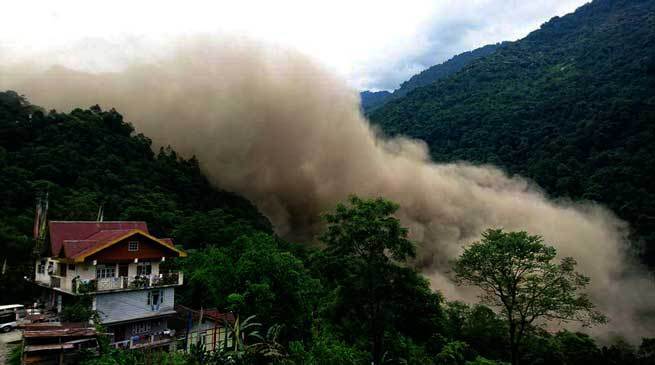
landslides in north sikkim
The Federation even asserted that the failure of Sikkim government to complete and commission the 400 kv transmission line from Teesta-III hydro power station to 400 kv grid substation Kishanganj (Bihar) has caused serious transmission bottleneck in Sikkim, resulting in loss of over 500 MW power continuously with financial impact of Rs 6 crore per day . This resulted in financial loss to TUL, now a Sikkim government company to the order of Rs 500 crore.
State Guaranteeing for private sector loss: The Private Equity funds investing in Teesta III are worried of the financial losses incurred due to the delays in commissioning of Teesta III and the reduced production of power. The Sikkim government has been forced to make an official statement that in the eventuality of the PE investors and other equity partners quitting at this advanced stage, it will buy off 100 percent equity in the project.
The Sikkim state, with an annual budget of Rs 2060 crores had to borrow heavily to compensate the losses of the private equity funds, even as it already has a loan of Rs.800 crore from the Power Finance Corporation (PFC) in order to meet its existing equity commitment. In August 2015, India's Power Ministry recommends National Hydroelectric Power Corporation (NHPC) purchase private equity shares to ensure the Teesta III is completed.
The government's move is intended to encourage continued foreign investment in India's hydropower . The Sikkim Government buying off additional stakes in TUL despite incurring losses and by selling power from Teesta III at a loss will only exert more pressure to Sikkim's coffers and its peoples.
IFIs involvement and unaccountability: Most of the private equity funds involved in the financing of Teesta III are financed by the International Financial Corporation (IFC), private sector arm of the World Bank, through financial intermediaries and private equity funds.
Commercial banks like ICICI, construction companies lke the Larsen and Turbo Ltd and private equity funds like Goldman Sachs, Morgan Stanley, Everstone, Norwest Partners etc have investments from IFC, which also brings in a different context of financing process of hydropower projects in India's North East and issues of governance, regulations and accountability issues of these financial institutions, corporations, equity funds etc for rights violations of indigenous peoples and destroying environment in Sikkim and for fleeing and absolving responsibility when their profitability is threatened.
The IFC-supported banks have arranged $3.19 billion in financing for NHPC Limited, involved in building dams in Bhutan, Burma and in Nepal and across India's North East etc . In India, dam building multinational companies like India's National Hydroelectric Power Corporation (NHPC) and Jindal Power received investment form IFC, bankrolling these companies through its support for six Indian commercial banks, such as HDFC, Kotak Mahindra, Yes Bank and ICICI banks.
The NHPC, the biggest dam building public company in India leveraged financing from the Deutsche Bank, JICA and Export Development Canada (EDC). Other companies receiving IFC investments includes the Vedanta Resources, NHPC Limited and Jindal Steel & Power, all involved in human rights violations. Jindal Steel & Power Limited that envisaged building several hydroelectric power corporations in Arunachal Pradesh, viz, the 3097 MW Etalin Hydroelectric Project, 1800 MW Kamala Hydroelectric Project and the 500 MW Attunli Hydroelectric Project has benefited from IFC funding through financial intermediaries, like HDFC, Kotak Mahindra.
There are massive complaints of human rights abuse by Jindal Steel in Central India and in many African countries . The IFC-supported commercial banks have arranged $3.19 billion in financing for NHPC, which has dispossessed thousands of indigenous communities in Manipur by its 105 MW Loktak Multipurpose Hydroelectric Project. These financings by IFIs, primarily by the IFC, the ADB, JICA, KfW etc are all intended to promote the interest of the corporate bodies, many of which are private corporations and to consolidate their profit, wealth and power, by destroying sources of livelihood and cultures of indigenous peoples.
Neither the companies receiving support from the International financial institutions like the IFC, nor the IFC itself are held accountable for the violations, the failure of the projects. The money could have better been invested in more worthwhile projects or in initiatives that could uplift people from poverty.
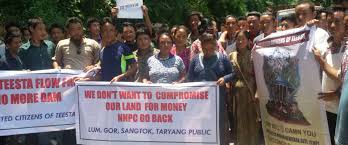
no to hydro power projects
Conclusions: The Teesta III project has been subjected to one of the most complex financing processes, involving private equity funds and very discreet financing of the major international financial institutions, the International Financial Corporation of the World Bank Group. The profit motive and the lack of accountability of private financiers and corporations such as Glenco, Goldman Sachs is clearly revealed when they start seeking financial claims or pressures to the Government to recover their losses when the project got delayed substantially or prospects of profits and returns is much dimmer.
Indeed, Teesta III is much delayed, the Earthquake and the losses incurred to the dam building company. The Teesta III is also a clear instance as to how the private company would invest in anything that would assure them high returns, such as Hydro Power or extractive industries.
An interesting aspect of Teesta III is how a mega hydroelectric project constructed in one of the most fragile terrains and biodiversity is being classified as a green, clean and renewable energy and indeed, the Teesta Urja Limited tried to claim carbon credits from the Clean Development Mechanism of the UN Framework Convention on Climate Change, which is very much an unethical and corporate manipulations, all the further the profit motive of the corporate bodies.
There is hardly any reason to justify that the Teesta III project with its massive tunnels and submergence of agriculture land and forest areas and the devastation of peoples' land and lives and future be classified as sustainable and climate friendly projects. Rather, the project and many other mega dams planned across the NE region are destroying the earth and polluting the environment with the massive emission of green house gases. The dams in Sikkim are not green and clean and will only worsen global warming.
The 1200 MW Teesta III Project besides being a failed public-private partnership also brings up an interesting aspect of increased impracticability of hydropower projects . The States who signed the Power Purchasing agreement with the TUL refused to buy power at the rate prescribed by the company for Teesta III. The cost of power per unit has become much cheaper and the Teesta Urja Limited, after investing near 14000 Crores cannot sell power at a loss and hence must sell power at a rate that assured profit for them. But times are a changing and power prices are becoming cheaper. The company is forced to sell power at a loss indicating the irrationality of hydropower projects.
But the interesting part is Glenco, the private company with backing of major private equity fund, Gold man Sachs etc withdraws from the project, possibly because of seeing no prospect from the project. And the Sikkim Government is forced to buy out the Stake of Glenco. One need to find an answer why a local Government with limited resources is forced to doll out Indian Rupees 4000 Crores when its annual budget is much lesser to the amount.
Is it because of the guarantee to the risks of investment financing by Glenco and oth-er private equity funds in Teesta III project? It is worth introspecting how the Teesta III is benefiting Sikkim after colossal impacts, cost overrun etc. Is the Teesta III project already a liability to Sikkim? Who will pay back the 4000 crores to the Government?
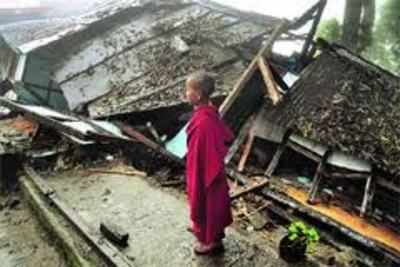
North sikkim destruction boy
Questions arose on how to ensure accountability of commercial banks like ICICI, companies like the Larsen and Turbo Ltd and private equity funds like Goldman Sachs, Morgan Stanley, Everstone, Norwest Partners and even the International Financial Corporation that are involved in one way or another in destroying peoples lives and future of indigenous peoples of Sikkim.
The financings of Hydros by these private equity funds, international financial institutions and increased involvement of multinational companies and private sector in hydropower, infrastructure, extractive industries in NE need be carefully assessed given the focus to leverage these marketing instruments to finance sustainable development and climate change solutions. Mega hydro power projects like Teesta III, financed by these private sectors, private equity funds etc are neither sustainable nor climate friendly or advancing the rights and wellbeing of communities.
Rather, these projects only unleashed violations, destroyed earth and undermined indigenous cultures, thus negating the very efforts to realize sustainable development goals. There have been no regulatory and accountability mechanisms for these corporations and equity funds that intensify their involvement in development processes impacting indigenous peoples land like hydropower, mining, oil exploration in Sikkim, Manipur etc.
The rationality to build large dam like Teesta III, that entails wide devastation and adding fragility to the land, that contributes to climate change with massive emission of greenhouse gases, that impoverishes indigenous peoples of Sikkim, who lives amidst constant tremors and fears in Chumthang village since the commissioning of the dam in 2017, need be questioned.
The complex financing of Teesta III, the unaccountability of corporations, the failure to generate 1200 MW of power, loss making, the withdrawal of private financiers, the guarantees for private sector and overburdening of local governments must be an eye opener in renewed hydropower push in NE region. Especially, as the Government of India is reinvigorating the hydropower as renewable sources of power and the declaration of mega hydropower projects as a renewable energy in early 2019 and expressed intentions to seek financing from international financial institutions and other development financial institutions.
References :
1] “India commissions 1,200-MW Teesta Stage III hydropower project in Sikkim”, 02/20/2017, By Elizabeth Ingram, Hydro Review
https://www.hydroworld.com/articles/2017/02/india-commissions-1-200-mw-teesta-stage-iii-hydropower-project-in-sikkim.html#gref
2] “Chungthang, Sikkim: A New Dam's Potential Impact”, By Tom Clement, the Pulitzer Center, 3 September 2014.
https://pulitzercenter.org/reporting/chungthang-sikkim-new-dams-potential-impact
3] “Sikkim cloudburst: Teesta water levels recede, but alert still on”, East Mojo,
Dichen Ongmu, 18 Jun, 2019 https://www.eastmojo.com/author/dichen-ongmu
4] “Govt clears Rs9,000 crore Teesta hydropower project in green energy push”, 10 Sep 2015, Live Mint
Rajesh Kumar Singh, Anindya Upadhyay, Debjit Chakraborty
https://www.livemint.com/Politics/9Drwz2IPErFJO3qcYfCbgN/Govt-clears-Rs9000-crore-Teesta-hydropower-project-in-green.html
5] “Govt clears Rs9,000 crore Teesta hydropower project in green energy push”, 10 Sep 2015, Live Mint
Rajesh Kumar Singh, Anindya Upadhyay, Debjit Chakraborty
https://www.livemint.com/Politics/9Drwz2IPErFJO3qcYfCbgN/Govt-clears-Rs9000-crore-Teesta-hydropower-project-in-green.html
6] “What ails Sikkim’s Teesta hydropower project?”, India Together, 7 September 2015
http://indiatogether.org/sikkim-teesta-iii-hydropower-project-irregularities-economy
7] “Construction to continue at 1,200-MW Teesta-III hydroelectric project”, 09/14/2015, Hydro World
https://www.hydroworld.com/articles/2015/09/construction-to-continue-at-1-200-mw-teesta-iii-hydroelectric-project.html
8] Teesta III – A failed PPP Project, Alleges AIPEF, the Economic Times, 25 June 2017
//economictimes.indiatimes.com/articleshow/59308055.cms?utm_source=contentofinterest&utm_medium=text&utm_campaign=cppst
9] “Delay in Teesta III line causes Rs 6 cr loss per day: AIPEF”, The Economic Times, 19 June 2018
//economictimes.indiatimes.com/articleshow/64649339.cms?from=mdr&utm_source=contentofinterest&utm_medium=text&utm_campaign=cppst
10] “Indian government backs US$1.48 billion 1,200-MW Teesta Stage-III hydroelectric project”,
By Gregory Poindexter, 4 August 2015, The Hydro Review
https://www.hydroreview.com/2015/08/04/indian-government-backs-us-1-48-billion-1-200-mw-teesta-stage-iii-hydroelectric-project/#gref
11] “Bankrolling India’s Dirty Dozen”, Inclusive Development International, December 2016
12] “Mozambique Villagers Exposed to Open-Pit Coal Mine”, By Jinty Jackson, 27 August 2013
https://www.voanews.com/africa/mozambique-villagers-exposed-open-pit-coal-mine
13] “Construction to continue at 1,200-MW Teesta-III hydroelectric project”, By Gregory B, Hydro World
* Jiten Yumnam wrote this article for e-pao.net
The writer can be contacted at mangangmacha(AT)gmail(DOT)com
This article was webcasted on November 05 , 2019.
* Comments posted by users in this discussion thread and other parts of this site are opinions of the individuals posting them (whose user ID is displayed alongside) and not the views of e-pao.net. We strongly recommend that users exercise responsibility, sensitivity and caution over language while writing your opinions which will be seen and read by other users. Please read a complete Guideline on using comments on this website.








